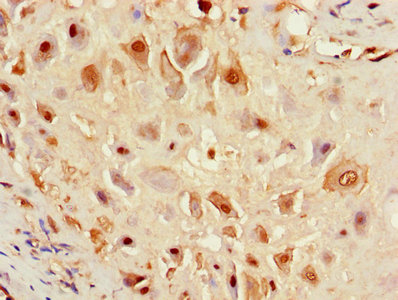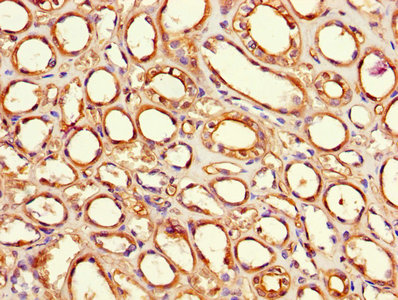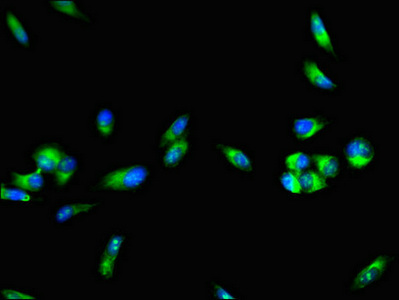F8 Antibody
-
货号:CSB-PA007932LA01HU
-
规格:¥440
-
促销:
-
图片:
-
Immunohistochemistry of paraffin-embedded human placenta tissue using CSB-PA007932LA01HU at dilution of 1:100
-
Immunohistochemistry of paraffin-embedded human kidney tissue using CSB-PA007932LA01HU at dilution of 1:100
-
Immunofluorescent analysis of Hela cells using CSB-PA007932LA01HU at dilution of 1:100 and Alexa Fluor 488-congugated AffiniPure Goat Anti-Rabbit IgG(H+L)
-
-
其他:
产品详情
-
产品描述:
The F8 antibody is a polyclonal antibody raised in the rabbit against the recombinant human coagulation factor VIII protein. It is available as the unconjugated IgG isoform. And it only reacts with the F8 protein of human origin. This antibody is protein G purified, and its purity is greater than 95%. It has been validated for use in ELISA, IHC, and IF. Its target protein coagulation factor VIII is activated in response to injury and then separates from the von Willebrand factor. Active coagulation factor VIII interacts with coagulation factor IX, triggering a series of chemical cascades that forms a blood clot.
-
产品名称:Rabbit anti-Homo sapiens (Human) F8 Polyclonal antibody
-
Uniprot No.:P00451
-
基因名:
-
别名:AHF antibody; Antihemophilic factor antibody; Coagulation factor VIII antibody; coagulation factor VIII; procoagulant component antibody; coagulation factor VIIIc antibody; DXS1253E antibody; F8 antibody; F8b antibody; F8c antibody; FA8_HUMAN antibody; factor VIII F8B antibody; Factor VIIIa light chain antibody; FactorVIII antibody; FVIII antibody; Hema antibody; Hemophilia A antibody; Hemophilia; classic antibody; OTTHUMP00000061446 antibody; OTTHUMP00000196174 antibody; Procoagulant component antibody
-
宿主:Rabbit
-
反应种属:Human
-
免疫原:Recombinant Human Coagulation factor VIII protein (1-216AA)
-
免疫原种属:Homo sapiens (Human)
-
标记方式:Non-conjugated
本页面中的产品,F8 Antibody (CSB-PA007932LA01HU),的标记方式是Non-conjugated。对于F8 Antibody,我们还提供其他标记。见下表:
-
克隆类型:Polyclonal
-
抗体亚型:IgG
-
纯化方式:>95%, Protein G purified
-
浓度:It differs from different batches. Please contact us to confirm it.
-
保存缓冲液:Preservative: 0.03% Proclin 300
Constituents: 50% Glycerol, 0.01M PBS, PH 7.4 -
产品提供形式:Liquid
-
应用范围:ELISA, IHC, IF
-
推荐稀释比:
Application Recommended Dilution IHC 1:20-1:200 IF 1:50-1:200 -
Protocols:
-
储存条件:Upon receipt, store at -20°C or -80°C. Avoid repeated freeze.
-
货期:Basically, we can dispatch the products out in 1-3 working days after receiving your orders. Delivery time maybe differs from different purchasing way or location, please kindly consult your local distributors for specific delivery time.
相关产品
靶点详情
-
功能:Factor VIII, along with calcium and phospholipid, acts as a cofactor for F9/factor IXa when it converts F10/factor X to the activated form, factor Xa.
-
基因功能参考文献:
- This study describes an original pathological mechanism by which a small intronic deletion in F8 leads to Alu exonization. PMID: 29357978
- A common polymorphism decreases LRP1 mRNA stability and is associated with increased plasma factor VIII levels PMID: 28431990
- F8 and F9 gene variants result from a founder effect in two large French haemophilia cohorts PMID: 29656491
- our results demonstrate that the N-glycosylation sequon in the A2 domain is located in a structural element that is critically required for proper folding and conformation of FVIII. PMID: 28327546
- The aim of this study was to determine the F8 mutations in severe HA (sHA) patients and female carriers PMID: 29938987
- Human FVIII gene transfer without in vivo selection of manipulated cells can introduce immune tolerance in hemophilia A mice and this immune tolerance is CD4(+) T cell mediated. PMID: 28799202
- In Factor VIII, 41 mutations were identified, 19 of which were novel and 80% (44/55) of the pathogenic mutations fell into the categories of missense, nonsense(16.36%), frameshift (14.55%), and splice (5.45%) mutations. PMID: 28252515
- High dose of rhFVIII induces apoptosis in FVIII-specific memory B-cells but does not influence FVIII-specific T cell response. PMID: 28492697
- the potential role of FXIII-A in wound healing, as a field with long-term therapeutic implications, is also discussed PMID: 28894750
- Case Report: complex recombination with deletion in the F8 and duplication in the TMLHE mediated by int22h copies during early embryogenesis in proband's mother. PMID: 28492696
- Report a diagnostic algorithm that can reliably identify pathogenic variants of factor 8/9 and von Willebrand factor and diagnose patients with hemophilia A, hemophilia B or von Willebrand disease. PMID: 27734074
- Each hFVIII vector was administered to FVIII knockout (KO) mice at a dose of 10(10) genome copies (GC) per mouse. Criteria for distinguishing the performance of the different enhancer/promoter combinations were established prior to the initiation of the studies. PMID: 28056565
- Relevance of ethnic differences in factor XIII activity on laboratory reference ranges. PMID: 28488800
- analysis of co-existing variants in both F8 and PTGS-1 genes in a three-generation pedigree of hemophilia A PMID: 27629384
- Potential mutations of the F8 gene were analyzed. PMID: 28777843
- FVIII endocytosis is driven by interaction with LRP1 PMID: 28558995
- Of special importance is the sequential formation of disulfide bonds with different functions in structural support of VWF multimers, which are packaged, stored and further processed after secretion. Here, all these processes are being reviewed in detail including background information on the occurring biochemical reactions. [review] PMID: 28139814
- The FVIII C1 domain contributes significantly to the immune response against FVIII in acquired and congenital hemophilia inhibitor patients. PMID: 28507083
- the existing epidemiologic investigations with an overview of the range of possible biochemical and immunologic mechanisms that may contribute to the different immune outcomes observed with plasma-derived and recombinant FVIII products. PMID: 28432221
- discuss potential mechanisms through which these intronic SNPs regulate ST3GAL4 biosynthesis and the activity that affects VWF and FVIII PMID: 27584569
- the half-life of VWF ( approximately 15 hours) appears to be the limiting factor that has confounded attempts to extend the half-life of rFVIII. PMID: 27587878
- results revealed localized vascular expression of FVIII and von Willebrand factor and identified lymphatic endothelial cell as a major cellular source of FVIII in extrahepatic tissues. PMID: 27207787
- NGS analysis has identified a large deletion of exon 2 of the F8 gene in a family affected with hemophilia A. PMID: 27984605
- the results indicate that residues in the C1 and/or C2 domains of factor VIII are implicated in immunogenic factor VIII uptake, at least in vitro Conversely, in vivo, the binding to endogenous von Willebrand factor masks the reducing effect of mutations in the C domains on factor VIII immunogenicity. PMID: 27758819
- Galectin-1 and Galectin-3 are novel-binding partners for human FVIII. Gal-1 binding can influence the procoagulant activity of FVIII. PMID: 27013611
- In general, NGS provides an effective approach to screen for different HA causing mutation types in the F8 gene. PMID: 27824209
- Our results confirm the rare event of Haemophilia A and haemophilia B in the same patient originating from two distinct genetic defects in F8 and F9 genes. PMID: 27824213
- although fVIII bound avidly to soluble forms of clusters II and IV from LRP1, only soluble cluster IV competed with the binding of fVIII to full-length LRP1, revealing that cluster IV represents the major fVIII binding site in LRP1. PMID: 27794518
- The FVIII B domain variants, p.D963N, p.S806T, p.G873D, p.H998Q and p.Q1225R may be considered as polymorphism or non-pathologic mutations in patients with Haemophilia A. PMID: 26915717
- In this meta-analysis, we have assessed the association between the FXIII-A Val34Leu polymorphism and intracerebral hemorrhage risk. The results of a combined analysis showed no significant association between the FXIII-A Val34Leu polymorphism and ICH risk in the overall population. The results of this meta-analysis suggest that the FXIII-A Val34Leu polymorphism is not associated with ICH risk in a Caucasian population. PMID: 27525858
- this study shows that targeted high-throughput sequencing is an effective technique to detect the F8 gene mutations in hemophilia patients PMID: 27292088
- F8 intron 22 inversions and SNP rs73563631 have roles in severe hemophilia A in unrelated families PMID: 26489971
- von Willebrand factor binds to the surface of dendritic cells and modulates peptide presentation of factor VIII. PMID: 26635035
- Desmopressin acetate increases F8 plasma concentration in patients with combined deficiency of factors V and VIII. PMID: 26599105
- 37 (70%) of the 53 had discordant antigen-activity ratio, majority of those mutations produced FVIII with low FVIII-specific activity. However, 4 (7.5%) of the 53 mutations produced higher specific activity of FVIII. It is possible that these mutations either produce a secretory defect or an increased metabolic turnover to account for the low levels of FVIII with these mutations. PMID: 25550078
- In situ genetic correction of F8 intron 22 inversion in hemophilia A patient-specific induced pluripotent stem cells has been described. PMID: 26743572
- Platelet-targeted FVIII gene therapy has higher therapeutic efficacy compared to factor VIII replacement therapy may be due to accelerated thrombin generation. PMID: 26453193
- Five int22h homologous copies at the Xq28 locus identified in intron22 inversion type 3 of the Factor VIII gene. PMID: 26653368
- Letter: report deep intronic variants of factor VII gene in hemophilia A. PMID: 26246214
- Carriers of Inv22 or Inv1 of F8 may be precisely detected with inverse-shifting PCR PMID: 27455009
- Factor VIII 3E6 antibody binding decreases the thermal motion behavior of surface loops in the C2 domain on the opposing face, thereby suggesting that cooperative antibody binding is a dynamic effect. PMID: 26598467
- 3030 SNPS, 31 Indels and a large, 497 kb, deletion were found among 2535 subjects from 26 different ethnic groups participating in the 1000 Genomes Project. PMID: 26383047
- Coagulation test results showed that the presence of double Glu113Asp, Arg593Cys mutations has a slightly synergistic effect on FVIII activity. PMID: 26057490
- Report a dose-response relationship between high FVIII levels and risk of death in venous thrombosis patients and in individuals from the general population. PMID: 26264493
- Case Report: P1809L mutation in A3 induced the conformational change in the FVIII molecule that hampered antigenic determinant(s) located in the C2 domain and might result in the inhibitor development. PMID: 26278069
- FVIII predicted venous thrombosis recurrence in a dose-response fashion, overall and in several subgroups, and is a strong candidate component of recurrence prediction tools. PMID: 26270389
- FXIII expression was upregulated in the airways of asthmatic patients after allergen exposure. PMID: 26525229
- Interaction between VWF and FVIII in treating VWD. PMID: 25605439
- large F8 rearrangements pose the highest risk, while missense mutations pose the lowest risk of inhibitor development in Indian hemophilia A patients PMID: 26897466
- Identify deep intronic variants in 15 haemophilia A patients by next generation sequencing of the whole factor VIII gene. PMID: 25948085
显示更多
收起更多
-
相关疾病:Hemophilia A (HEMA)
-
亚细胞定位:Secreted, extracellular space.
-
蛋白家族:Multicopper oxidase family
-
数据库链接:
HGNC: 3546
OMIM: 134500
KEGG: hsa:2157
STRING: 9606.ENSP00000353393
UniGene: Hs.632836
Most popular with customers
-
-
Phospho-YAP1 (S127) Recombinant Monoclonal Antibody
Applications: ELISA, WB, IHC
Species Reactivity: Human
-
-
-
-
-
-
























